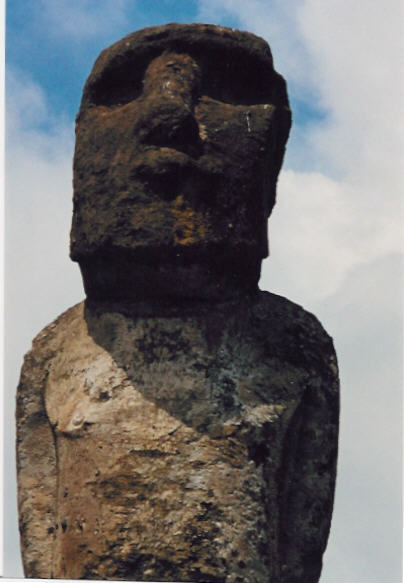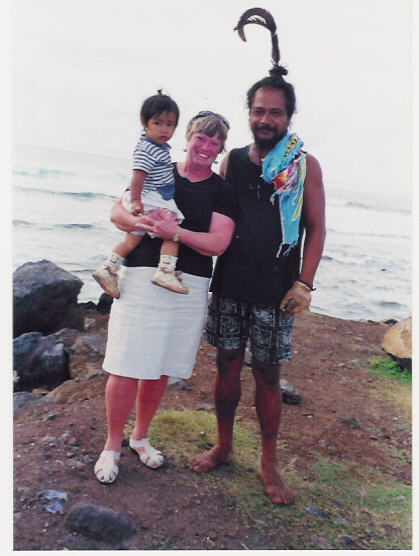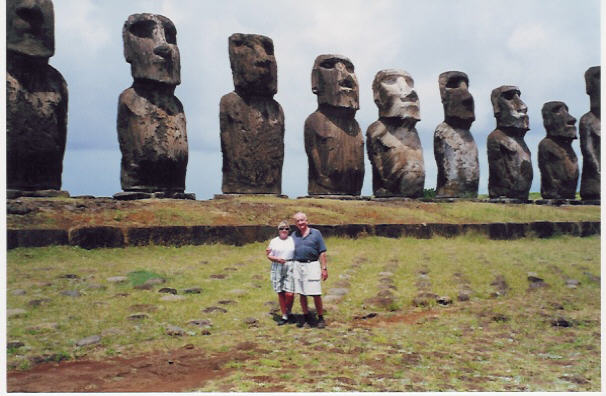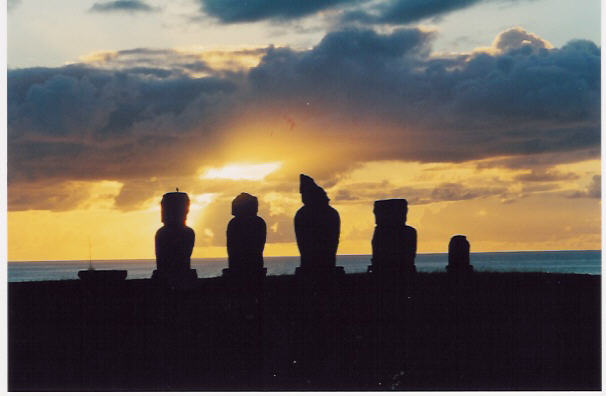
Easter Island (2000)
The Loneliest Island in the World Antarctica was always our primary destination. Easter Island was an after thought. With a stopover scheduled for Chile on the way down to Antarctica, we got to thinking that, as long as we were ‘in the neighborhood’, why not tack on a visit to Easter Island on the way. Just fly down to Santiago and take a right. Well, it turned out that it was a five hour, 2,300 mile flight out to Easter Island . . . but it was a wonderful detour. |
Easter Island is known as the "loneliest island in the world". It is 1,130 miles from the next closest inhabited island . . . Pitcairn Island (pop. 65) of Mutiny on the Bounty fame. It is fourteen miles long by seven miles wide and home to only three thousand islanders. It was first discovered by Dutch explorers in 1722 on Easter Day, who gave it it’s name. The native name for the island is Rapa Nui and they also refer to it by it’s more colorful name Te Pito o Te Henua (Navel of the World).
History. Although there has been some disagreement about the origin of the first islanders, it is generally accepted now that the island was first settled by Polynesians who sailed from the western Pacific in 500 A.D. in an amazing feat of navigation and seamanship. Almost totally isolated from the rest of the world through the years, it was visited only once a year by a Chilean navy ship as recently as the 1950’s. Even today a cargo ship comes only three or four times a year to bring supplies to the island. The island airport was extended in 1985 (with funds from the U.S. taxpayers) to serve as a possible emergency landing site for the space shuttle program and now accommodates three flights a week from the mainland. (I’d love to be there on the day the shuttle lands to see the reaction on the faces of the locals!).
Tourist accommodations are modest but comfortable . . . a few small, one story hotels. What they lack in amenities, they make up for in the charm of their beautiful gardens. The menu was mostly fish served in open-air restaurants along the ocean shore. Our most notable culinary discoveries were saviche (raw tuna with chopped tomatoes, onions and peppers), pisco sours (a Chilean cocktail of some potency) and fresh pineapples pealed by street vendors to eat off the stalk like corn-on-the-cob. We could have survived very nicely on that menu for a long time!
Moai. The principal attractions of Easter Island are, of course, the giant stone statues known as moais, which were made famous by Thor Heyerdahl (author of Kon Tiki) in his book "Aku Aku". Over six hundred of these stone monoliths are spread out over the island . . . most fallen over or incomplete . . but with about sixty standing in majestic splendor at a dozen sites around the island. Val and I have known about the giant statues since we read Aku Aku in the 50’s but nothing prepared us for the sight of our first statues. Standing in their presence is a awesome experience and you almost feel that they are speaking down to you through the ages.
The moai are carved from volcanic lava rock in a quarry located inside the crater and on the outside slopes of a large volcano, Rano Raraku. They range in size from an average of 25 feet and 50 tons to the largest, a massive 70 feet long giant weighing 140 tons and still lying in a recumbent position as it was when it was first carved. It is estimated that it required one hundred workers a full year to carve a statue after which they were transported to a dozen or so family (or tribal) altars (called ahu) around the perimeter of the island where they were raised (facing the tribal village with their backs to the sea) and served to venerate the tribal ancestors and to show the importance of the tribe. The larger the statue, the more important the tribe. Although the first moai were thought to have been constructed in 700 A.D., most were built between 1000 and 1500 A.D.
 |
 |
 |
Moai Mysteries. There is still a great mystery on how the giant statues were transported to their final resting places some up to ten miles from the quarry. Theories range from dragging them along channels using squashed yams to lubricate the path to levitation by local witch doctors with powers of mana. Ask any Rapa Nuian today how the statues were moved and they will answer without hesitation that the witch doctors made them walk. I guess that I can live with that. It sounds as logical to me as the squashed sweet potato theory.
The other great mystery is why the work stopped so abruptly. Work on hundreds of statues were stopped in various states of completion and transportation was halted across the island at the same time that all the older statues were pushed over on their faces. Again the locals tell the tale of an irate witch doctor who toppled the statues with mana. More likely it was the result of tribal wars. Unfortunately, the oral history of the island was lost when the native islanders were taken off the island by the Peruvians in 1862 to serve as slaves in the guano mines on the mainland with less than a hundred surviving and eventually returning to the island.
Bird Man. A bit of more recent 19th century history that fascinated us was the annual bird-man competition in which a representative was selected from each tribe/family to compete for birdman honors (the Easter Island Olympics) which involved swimming through shark infested waters to a small island two miles off the coast to find the first sooty tern egg of the new season and return with it to the ceremonial village of Orongo, without breaking the egg. The winner (along with his tribe) was accorded honors and privileges (and bragging rights) for the year.
We were fortunate to have our own guide for our three day visit, an engaging Aussie, named Larry Sandy, with great charm and knowledge of the island who took us to all it’s places of interest. Larry had come to the island with Kevin Kostner to work on a movie (called "Rapa Nui"), married a Rapa Nui woman and settled on the island. The move wasn’t a great commercial success but does a nice job of telling the history of the island and Larry had some great stories about the behind-the-scenes life of a film set construction supervisor.
As we sat on the beach watching the sunset on our final night on Easter Island, with the flame colored sky providing a spectacular backdrop for the giant statues on the waterfront, we agreed that, even if we had returned home following our short stay on Easter Island without ever proceeding on to Antarctica, our trip would have been well worth the time and distance
 |
 |
The next day we flew back to the mainland and received a mysterious upgrade to first class seats on our LanChile flight. There was no explanation given. I’m convinced it was mana at work again. On the following day we left for Antarctica.